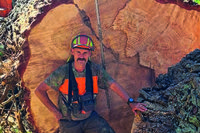
Working in harvesting crews on the East Coast for over 32 years, doing predominantly tall tower difficult terrain logging, Tairawhiti Timber Training’s Alan Paulson would often come across edge trees that were difficult to fall.
“Five years ago, myself and my wife started our own business training, auditing, mentoring and doing specialised tree falling. This was at a time where I was looking forward to giving back to an industry that I had enjoyed so much. I saw a need for purpose-built tree jacks as a jack is a very safe way of falling difficult trees, requires minimal effort compared to pounding on wedges with a big hammer, and saves cost, especially for a cable crew who do not have to stop yarding as all their edge trees are already on the ground.
Alan started “playing around” trying bottle jacks that “weren’t that successful” and, before long, imported a 28-tonne Borntrager tree jack from the United States which “worked really well but didn’t quite have the capacity for a lot of the work I was doing”.
After discussions with Andy Costello at Hikurangi Forest Farms (now Aratu Forests), a forest owner Alan was working with, who had a number of archaeological sites in a coastal forest that needed to be preserved, Alan “took a punt” on purpose-built tree jacks and imported the 100-tonne Borntrager tree jack – made up of two
50-tonne cylinders that could be operated individually or together.
“This ended up working extremely well as we felled a lot of trees while keeping the sites one hundred percent preserved with no soil disturbance. Then we moved onto jacking edge trees along fence lines, keeping the fences preserved and, again, this worked well with big cost benefits to the forest owner and contractor who didn’t have to stop logging and back-pull these trees.
Plenty of pluses
Tree jacking is “actually pretty simple” says Alan, but you must be a very confident and competent faller.
He explains: “Generally if you have the likes of an edge tree that is heavily branched on the back side and there is no way you can fall it by wedging it over, you will just make a conventional quarter cut and scarf. Accurately measure a box to cut out of the back of the tree for the jack, seat the jack and apply some pressure and take the weight, then finish the last quarter cut and continue pumping the handle and jack the tree over.”
The advantages of jacking over wedging include:
Safety: Jacking edge trees is very safe as the faller is in total control and not relying on a third party in a machine.
Cost: If a logging crew can have all their trees on the ground before logging and not have to stop and back-pull a tree, it is a big saving.
Minimal effort: Compared to stacking up wedges to get a tree over.
Well-suited to edge trees and marginal trees on the fence line: The average edge tree is straight up and down with heavy branching at the back and hard to wedge...





